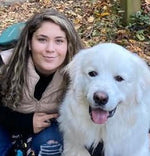
Help Your Cat or Dog with Anxiety
Stress and anxiety are never fun to deal with as people - and unfortunately dogs and cats can experience this emotion too. Whether it be caused by visitors in your house, thunderstorms, or fireworks, anxiety in pets can be hard to manage.
It’s not always easy to know what anxiety looks like for a dog or cat - that’s why the KOHA team is here to help! Keep reading to learn how to identify dog and cat anxiety, and the tips you can follow to help your pal feel more relaxed during stressful situations.
Understand the Signs of Anxiety
The first step in managing anxiety in dogs and cats is to identify the signs. Recognizing anxiety is essential for providing timely support and ensuring their overall well-being. By familiarizing yourself with the signs and symptoms of anxiety, you can take appropriate action to manage and alleviate your pet's stress.
Some symptoms of anxiety in dogs include:
- Excessive barking or whining
- Restlessness and pacing
- Destructive chewing or scratching
- Trembling or shaking
- Aggression or fearfulness
- Loss of appetite or excessive panting
Cats, on the other hand, may exhibit different signs of anxiety compared to dogs. Some key indicators include:
- Excessive meowing or yowling
- Avoiding social interactions or hiding
- Over-grooming or compulsive licking
- Changes in appetite or elimination habits
- Excessive scratching or urine marking
- Restlessness or pacing
What Causes Cat and Dog Anxiety?
There are many stressors that can cause anxiety in cats and dogs. This can include separation anxiety, situational anxiety, or even age-related or generalized anxiety.
Separation anxiety in cats and dogs can begin right before and/or when you or your family members leave the house. Your furry friend may notice when you grab your keys or put on your shoes for instance, and begin to display symptoms. Severe separation anxiety can be difficult to manage, as we typically cannot control when we need to leave our pets at home.
Separation anxiety in dogs and cats fall under the umbrella of situational anxiety. This is when there are specific stressors that trigger your pet and cause them to feel anxious. There may be a few situations that immediately come to mind for you: vet visits, groomer visits, thunderstorms, fireworks, etc. These are all common causes of situational anxiety that can lead to a stressed dog or cat.
It’s important to note that pet anxiety does not always have a specific cause. Sometimes, anxiety is a generalized problem that occurs on a more frequent basis. Genetics, environmental stressors, and early life experiences are a few of the main contributors that determine cat or dog anxiety. Some of our pets may naturally tend to stress out more than others.
Anxiety can also develop with age. As our pets get older, they unfortunately can become more limited mentally and physically. This is naturally stressful for them, and in turn causes them to become more anxious.
Whatever the cause is, the good news is that there are many steps you can take to help manage anxiety in cats and dogs.
How to Help a Cat or a Dog with Anxiety
1. Create a Safe Environment
Providing a secure and comforting environment is vital for anxious pets. Create a designated space, such as a quiet corner or a crate, where your pet can retreat when feeling overwhelmed. Make this area cozy by adding their favorite bed, toys, and familiar scents, such as a sweater of yours. Additionally, sticking to a predictable routine and maintaining a consistent schedule for feeding, exercise, and playtime can also help reduce anxiety.
2. Regular Exercise and Mental Stimulation
Exercise plays a significant role in reducing anxiety in pets. Engaging in regular physical activities not only burns off excess energy but also releases endorphins, which promote relaxation and happiness. Additionally, mental stimulation through interactive toys, puzzles, and training sessions can divert their attention from anxious thoughts and redirect their focus in a positive way.
3. Introduce Behavior Modification
Positive reinforcement training is an effective method for managing anxiety in pets. Reward desired behaviors with treats, praise, or play to reinforce a sense of security and boost confidence. Counter-conditioning, which involves associating anxiety-inducing situations with positive experiences, can gradually help pets overcome their fears. For instance, you can save a special toy or treat for your pet, that you only give to them when you leave. That way, they make a positive association with your absence, rather than a negative one.
You may want to consider getting assistance from a professional trainer or behaviorist to develop a tailored training plan in cases of moderate or severe anxiety.
4. Consider a Calming Supplement
Calming supplements can be extremely helpful to reduce anxiety in dogs and cats, especially before stressful events. Progility Calming for Dogs by Nootie is an easy, all natural solution to help your dog relax. It’s formulated with a combination of Melatonin, Valerian Root, Passion Flower, L-tryptophan, and L-theanine to naturally calm your dog. It also includes probiotics and thiamine (aka Vitamin B1) to give a healthy boost to their digestive and immune system at the same time.
5. Consult with a Veterinarian
If your pet's anxiety persists or worsens despite your efforts, consult a veterinarian. They can rule out any underlying medical conditions that may contribute to the anxiety and recommend additional strategies or medications, if necessary. Professional guidance ensures the well-being of your pet and provides you with expert support.
Managing anxiety in dogs and cats requires patience and understanding. By recognizing the signs of anxiety and knowing the approaches to minimize stress, you can significantly improve your pet's well-being and help them lead a calmer, happier life.
If you are concerned about your pet, please make sure to schedule a visit to a trusted clinic. This text cannot and should not replace advice from a licensed veterinarian. This blog is for educational purposes only.
Table of Contents
- Choosing a selection results in a full page refresh.
- Press the space key then arrow keys to make a selection.


